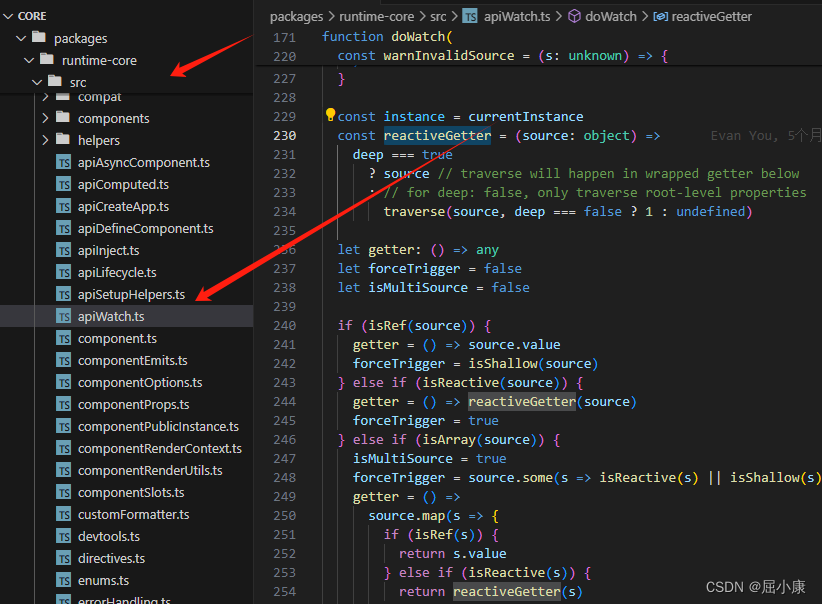1、Vue3相关语法内容
- 赋值语句(ref、reactive系列)
- 组件传值(父子,子父)
- watch,watchEffect监听
- slot具名插槽
1、赋值语法(ref,reactive)
1.1、ref 、isRef、 shallowRef、triggerRef、customRef 支持所有的类型(原因没有泛型约束)
##### 1、ref
// 简单数据类型 可以直接通过 赋值
type M {name:string;
}
const name = ref<M>('')// 复杂数据类型 可以直接通过 赋值
import type {Ref} from 'vue';
type M {name:string;
}
const name:Ref<M> = ref('屈小康')// 取值
name.value // 屈小康
name // Object// 为什么?
ref返回值是一个ES6的class的类,里面有一个 .value的属性,所以取值和赋值 都必须通过 .value 固定语法### 2、isRefisRef(name) // 判断定义的内容是否为一个ref定义的内容 返回 true/false.### 3、shallowRef //浅层响应式
const a = ref({name:'a'})
const b = shallowRef('b')// 改变值const handleClick = () =>{a.value.name = 'aa' // 页面展示 aab.value.name = 'bb' // 页面展示 b 页面没有发生改变,但是值已经发生改变 (也就是说没有双向数据绑定)b.value = {name:'bb' // 页面展示 bb 修改成功 这就是浅层 只绑定到 value属性}}
### 4、triggerRef 强制跟新 shallowRef### 5、customRef 自定义一个reffunction MyRef(value){return customRef((track,trigger)=>{return {get(){track();},set(newVal){value = newVal;trigger();},}})}
const name = customRef('1');
name.value // 1 输出内容## 6、获取 元素 相当于 v2的 this.$refs
<div ref="dom"></div>
// 获取 元素
const dom= ref(); // dom 必须和 ref="dom" 中的 dom 保持一致
// 获取
dom.value 相当于 this.$refs.dom
1.2、 reactive、readonly、shallowReactive (支持引用数据类型,泛型约束)
reactive (target:T) // 源码实例 继承与 object。
const stu = reactive({name:'屈小康'
})### 1.1 获取值stu.name // 屈小康
### 1.2 修改值
stu.name = '张三'
### 1.3 修改值(错误做法)
let obj = {name:'张三'}
stu = obj;
引用数据类型无法进行重新赋值### 2.1 readonly 只读属性
const name = raeadonly({}) // 不可进行操作后续属性(相对情况下,如果你的readonly依赖于reactive,这个时候修改reactive的时候就会变更)### 3.1 shallowReactive 浅层的 只到第一个属性。
const stu= reactive({age:14,person:{sex:'男'}
})
// 只影响到 stu.age
2、to系列(toRef、toRefs、toRaw)
2.1 toRef
用法:毫无卵用的用法(不能说这种用法是错的,只能说没有任何意义)
const stu = {name:"张三"};
const stus = toRef(stu,'name')
stus.name = '李四'; 值发生了改变,但是页面不会变还是 张三如何发生改变
const stu = reactive({name:"张三"}) // 这样进行 修改就好了
总结:非响应式使用的时候 没有任何作用。只能修改响应式的。2.2 toRefs
const stu = {name:"1",age:"2"};
const {name,age} = toRefs(stu);
总结:非响应式使用的时候 没有任何作用。只能修改响应式的。
2.3 toRaw
脱离响应式对象
const stu = {name:“1”,age:“2”};
toRaw(stu) // {name:“1”,age:“2”}
2、组件传值
2.1.1、父—>子 基本数据传参 [不是TS版](defineProps )
### Father 组件
<template>我是Father<Son :title="title"></Son>
</template>
<script setup>import Son from './b.vue';
import { ref } from 'vue';const title = ref('把这个值传给孩子组件');</script>#### Son 组件<template><div>我是孩子{{ title }}</div>
</template>
<script setup>
import { defineProps } from 'vue';## 简单 用法 不带默认值
defineProps ({title: String,
});## 带默认值
const props = defineProps({title: {type: String,default: '我是默认值'}
})</script>
2.1.2、父—>子 事件数据传参 [不是TS版](defineExpose)(父调用子组件的方法)
###### Fatner
<template>我是Father<Son ref="son"></Son><button @click="handleClick">点我</button>
</template>
<script setup>import Son from './b.vue';
import { ref } from 'vue';
const son = ref(null);const handleClick = () => {son.value.handleClick();
}</script>###### Son<template><div>我是孩子</div>
</template>
<script setup>
import { defineProps } from 'vue';const handleClick = () => {console.log('我被点击了!!')
}defineExpose({ handleClick })</script>2.1.3 子—> 父 事件传参【不是TS版本】($emit)
###### Fatner
<template>我是Father<Son @childEmit="childEmit"></Son>
</template>
<script setup>import Son from './b.vue';
import { ref } from 'vue';const childEmit = (value) => {console.log(value)
}</script>########### Son
<template><div>我是孩子<button @click="handleSend">点我</button></div>
</template>
<script setup>
import { defineProps } from 'vue';const emit = defineEmits(['childEmit']);const handleSend = () => {emit('childEmit', '数据')
}
</script>2.2.1 基本数据类型传参(TS版本)(withDefaults)
<template>我是Father<Son :title="title"></Son></template>
<script setup lang="ts">import Son from './b.vue';
import { ref } from 'vue';const title = ref<string>()</script><template><div>我是孩子{{ props.title }}</div>
</template>
<script setup lang="ts">import { defineProps } from 'vue';const props = withDefaults(defineProps<{title: string,}>(),{title: '默认值'}
)
</script>3、监听函数(watch,watchEffect)
3.1 watch
<template><input v-model="inputValue" /><input v-model="inputValues" /><input v-model="obj.stu.name" />
</template>
<script setup lang="ts">
import { reactive, ref, watch } from 'vue';const inputValue = ref<string>('')
const inputValues = ref<string>('')
const obj = reactive({stu: {name: ''}
})
watch([inputValue, inputValues], (newValue, oldValue) => {console.log(newValue, oldValue)
},{deep: true // 深度监听(新值和旧值是一样的如果是深层次的对象)})// 监听 对象的 某个属性
// reactive 会自动开启 deep:tru e
watch((()=> obj.stu.name), (newValue, oldValue) => {console.log(newValue, oldValue)
})### 同时还有以下属性
1、deep: true //开启深度监听
2、immediate:true //立即执行
3、flush:“pre” // pre 跟新之前调用,sync 同步执行 , post 组件更新之后执行
</script>
<style scoped lang="less"></style>### 主要源码解释(算了太多了没法解释了)
https://github.com/vuejs/core.git位置

3.2 watchEffect
// 立即执行
const stop = watchEffect((oninvalidate) => {console.log(inputValue); // 被改变后后执行oninvalidate(() => {console.log('我第一个执行!!!')})
})
// 停止监听 stop()cosnt click = () => stop(); //监听函数就会停止
1、flush:“pre” // pre 跟新之前调用,sync 同步执行 , post 组件更新之后执行
4、插槽(slot)
插槽就是子组件中的提供给父组件使用的一个占位符,用(< slot > </ slot>) 表示,父组件可以在这个占位符中填充任何模板代码,填充的内容会替换子组件的< slot>< /slot>标签。
4.1、具名插槽
// ### 子组件<div><slot name="header"></slot><slot></slot><slot name="footer"></slot></div>// ### 父组件使用<template v-slot:header><div>header</div></template><template v-slot><div>默认插槽</div></template><template v-slot:footer><div>footer</div></template>
4.2、作用于插槽
<slot name="header" :data=""></slot>const data = reactive({message:"我是一条消息"})// #header ==== v-slot:header<template #header="{data}">{{data.message}} // 我是一条消息</template>4.3、动态变量插槽
<template #[slot]>啦啦啦啦</template>
const slot = ref('header')
